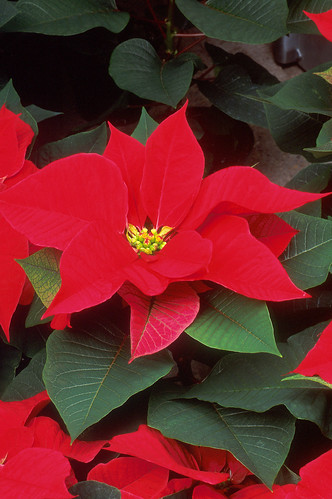
This post is part of the Science Tuesday feature series on the USDA blog. Check back each week as we showcase stories and news from USDA’s rich science and research portfolio.
Poinsettias are more than just an icon of the Christmas season. They’ve become the go-to plant for decorating homes, hotels, offices and just about everywhere from the Friday after Thanksgiving to well past New Year’s Day.
This wasn’t always the poinsettia’s story. In the 1950s, poinsettias were flashy plants that made a brief appearance in public places shortly before Christmas, only to drop their leaves and colorful flower-like bracts a few days later. They were expensive to grow because their blooming time was difficult to synchronize with the holidays, and the plants easily grew tall and leggy.
That shouldn’t be much of a surprise when you consider that wild poinsettias grow to be 8 feet tall in their native southern Mexico.
Then in the 1960s, USDA Agricultural Research Service (ARS) horticulturalist H. Marc Cathey began to use poinsettias in his research on the chemical control of plant growth. He found several compounds among the hundreds he tested, including some he got the makers of Old Spice (the Shulton Company), to prepare for him that growers could use as treatments to keep their plants compact.
Cathey went on to discover that exposing poinsettias to 3 seconds of light every minute—or 3 minutes every hour—from 11 p.m. to 1 a.m. each night held poinsettias on the brink of flowering until growers were ready to ship them for the holidays.
More improvements came in the 1970s. ARS geneticist Robert N. Stewart became interested in poinsettias, partly because he found them to be an excellent research model as evolutionarily primitive plants. The other reason was that at that time, many scientific meetings were held between Christmas and New Year’s, and at the beginning of the meetings, “hotel lobbies would be dressed up with poinsettias, but by the end of the meeting, I noticed all the leaves had dropped off the plants,” Stewart once recounted. He knew he could do something about that.
Stewart went on to develop poinsettia breeding lines known for their ability to last under non-greenhouse conditions and be naturally compact. His ‘Ruff and Ready’ variety is still used as a parent for new poinsettia cultivars being bred today, nearly 40 years later.
ARS’s most recent contribution to improving poinsettias is the work of plant pathologist Ing-Ming Lee. He discovered that phytoplasmas—minute organisms that usually cause plant diseases—induce the dense, free branching growth so highly prized in poinsettias. His finding also led the way for growers to produce virus-free plants.
Now, poinsettias are America’s number-one potted plant, with nearly 80 million sold for more than $250 million annually, even though the market is only 6 weeks long each year.
Happy holidays with a little agricultural research!


